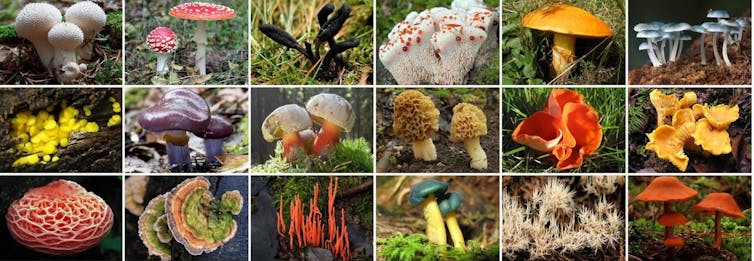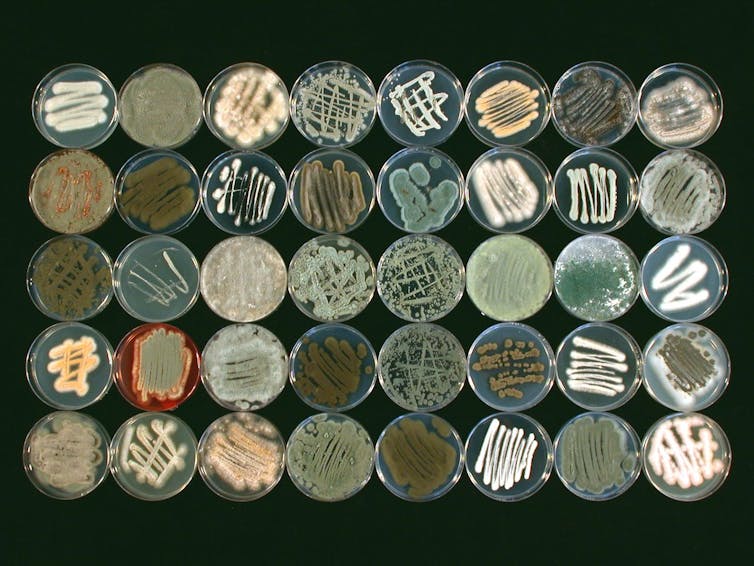How many fungi are threatened with extinction? To answer this question, we need to ask several others: How many species of fungi are there in total? What exactly is a fungus?
And, along the way, discover the mysterious and fascinating world of this kingdom that is neither plant nor animal.
Fungi are everywhere, yet so little known. They are neither plants nor animals. Alongside the plant and animal kingdoms, they form their own kingdom, which is home to a wealth of species and life forms. They play a fundamental role in the functioning of ecosystems and for humans. Many fungi, for example, help break down organic matter, which allows it to be recycled and makes nutrients available to plants again.
Many fungi also form associations with plants, directly exchanging nutrients for mutual benefit. Others are edible or are used in the production of beverages and foods through fermentation. Some even have the ability to extract pollutants from the soil through a process known as bioremediation or mycoremediation.

Diversity reigns supreme in the mushroom kingdom. Wikimedia, CC BY
It is difficult to say how many species of fungi exist, as most are invisible to the naked eye. Many cannot be cultivated in laboratories, which makes them even more difficult to identify and describe. Today, 155,000 species are known, but some studies estimate that between 2 million and 4 million species of fungi remain to be discovered and identified.
What is a mushroom?
But what exactly is a mushroom? That's a big question! The word “mushroom” is often associated with the image of a structure growing out of the ground, with a stem and a cap, or attached to a tree, shaped like an ear. However, most fungal species do not produce this type of structure. In species that do have them, this part of the mushroom contains the sexual spores. Its scientific name is “sporophore.” In English, this distinction is clear, as there are two distinct words: “mushroom,” which describes sporophores, i.e., the part found on certain fungi, and “fungus,” which describes all species belonging to the class Fungi.
The rest of the fungus's “body” is rarely visible and is very unusual. It is a microscopic network formed by hyphae. These hyphae are very elongated cells that form tunnels a few microns in diameter. Their branched network, called “mycelium,” develops in the substrate on which it grows (in the soil, on wood, on dead leaves, etc.) to seek and extract nutrients.
A fungus is therefore a single-celled (like yeast) or multicellular organism characterized by a cell wall containing chitin and immobile reproductive cells (called spores).
It is not a plant for many reasons: fungi do not photosynthesize and do not have sap. The cell wall of plants is composed of cellulose, not chitin.
Taking an interest in fungi means entering the world of the infinitely small, but also the infinitely large. In the late 1980s, scientists in Oregon (northwestern United States) discovered a specimen of Armillaria gallica that was nearly 2,500 years old and whose mycelium spread over more than 37 hectares.

Morphological diversity of several marine fungi. Wikimedia, CC BY
A growing red list
To find out how many fungi are currently threatened, we need to consult the red list published by the IUCN (International Union for Conservation of Nature). This is the most comprehensive inventory, listing species and their conservation status. The first edition was published in 1964. At that time, it only included rare mammals and birds
As for fungi in France, we will have to wait until 2024 for the first inventory of endangered fungi to be published by the French committee of the IUCN.
On March 27, the global red list was updated to include the status of 1,300 mushroom species. We are still a long way from the 155,000 known species, but the initial assessments remain worrying, with 411 mushroom species threatened with extinction, representing nearly a third of the species surveyed.
Although this number is significant, it is important to remember that, due to a lack of information, the species considered most vulnerable were listed first in order to facilitate the development of conservation projects.
Some of these species are rare and have only been detected in very limited geographical areas. In mainland France and Corsica, the red list includes 79 endangered species and 39 species classified as “near threatened.” This list includes lichens, such as Buellia asterella, classified as critically endangered, which has not been spotted in the country since 1960. There are also decomposing fungi, such as Laccariopsis mediterranea, which grows in the coastal dunes of the Mediterranean and whose populations are in sharp decline (by approximately 30% over the last 30 years).
Some species form symbiotic relationships with plants: the plants provide sugars from photosynthesis, while the fungi provide nutrients from the soil. These species are also threatened; for example, Cortinarius prasinocyaneus, a fungus associated with oak and hornbeam. In France, it is only listed at five sites.
Well-identified threats, much less clear repercussions
While the world of fungi remains largely unknown, as does the exact number of vulnerable species, one thing is certain: the threats to these species are well identified. These include changes in land use, particularly habitat destruction and deforestation, pollution linked to urbanization and agriculture (excessive fertilization and pesticides). Climate change is now adding to the other threats facing fungi.
Their loss could lead to changes in the functioning of ecosystems. Many fungi are involved in decomposition, an important process in the nutrient cycle. In the case of species that form symbiotic relationships with plants, these associations can be very specific, with fungi only able to associate with one or two tree species. This is the case with Geomorium gamundiae in Argentina and Destuntzia rubra in China and Japan, species that are critically endangered due to deforestation threatening their host plant.
But the reverse could also happen: if the fungus were threatened, this would have adverse consequences for its host.
Preserving fungi: still a long way to go
Unlike fauna and flora, there is no conservation plan for fungal species.
Knowledge about these organisms was too limited for them to be included in environmental laws when they were first introduced, and they have been largely overlooked in conservation projects. Currently, the only protection for these species is the protection and conservation of habitats through directives such as the Natura 2000 network in the European Union.
However, initiatives exist to promote research, knowledge, and the inclusion of fungi in legislation. Due to their ubiquity and role in the ecosystem, fungi form a kingdom that is just as important as plants or animals.
It is therefore essential to take them into account in order to protect ecosystems by integrating fauna, flora, and fungi.
Coline Deveautour, Associate Professor in Microbial Soil Ecology, UniLaSalle
This article is republished from The Conversation under a Creative Commons license. Read the original article.






